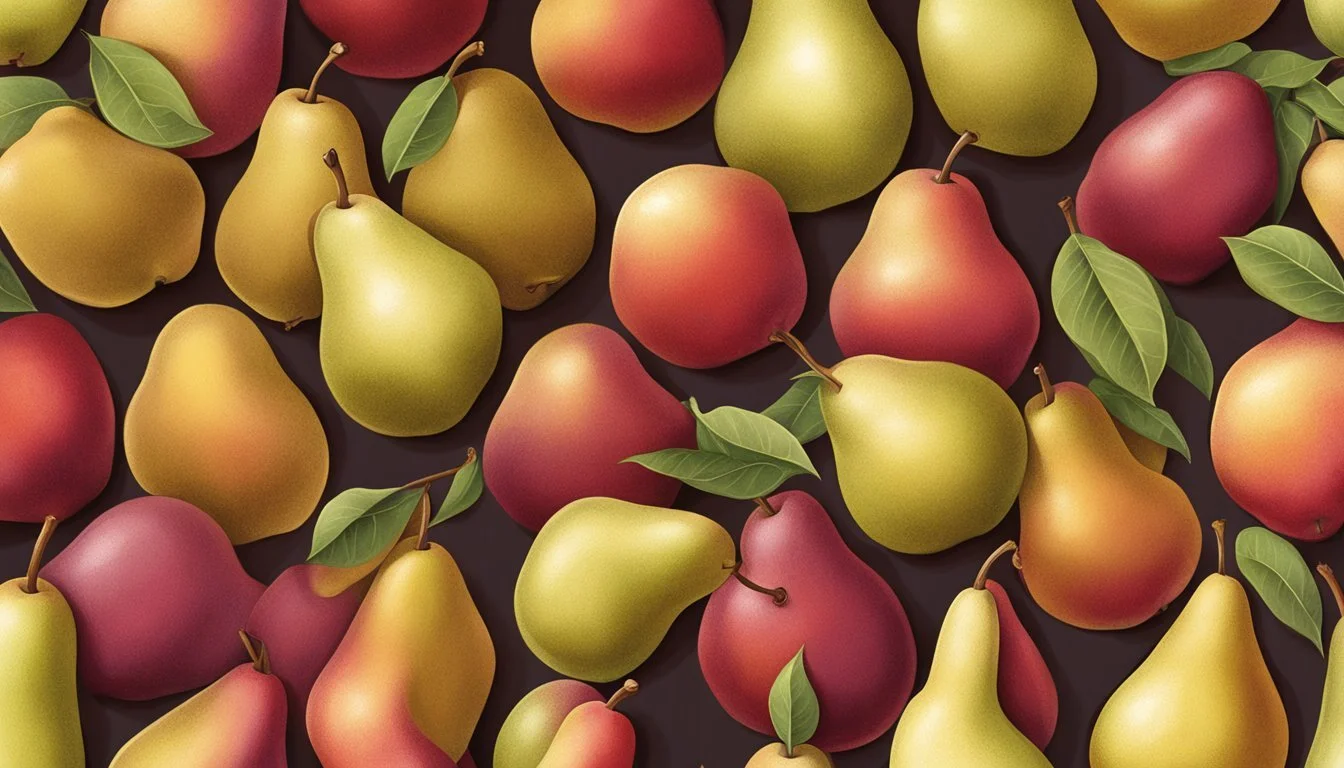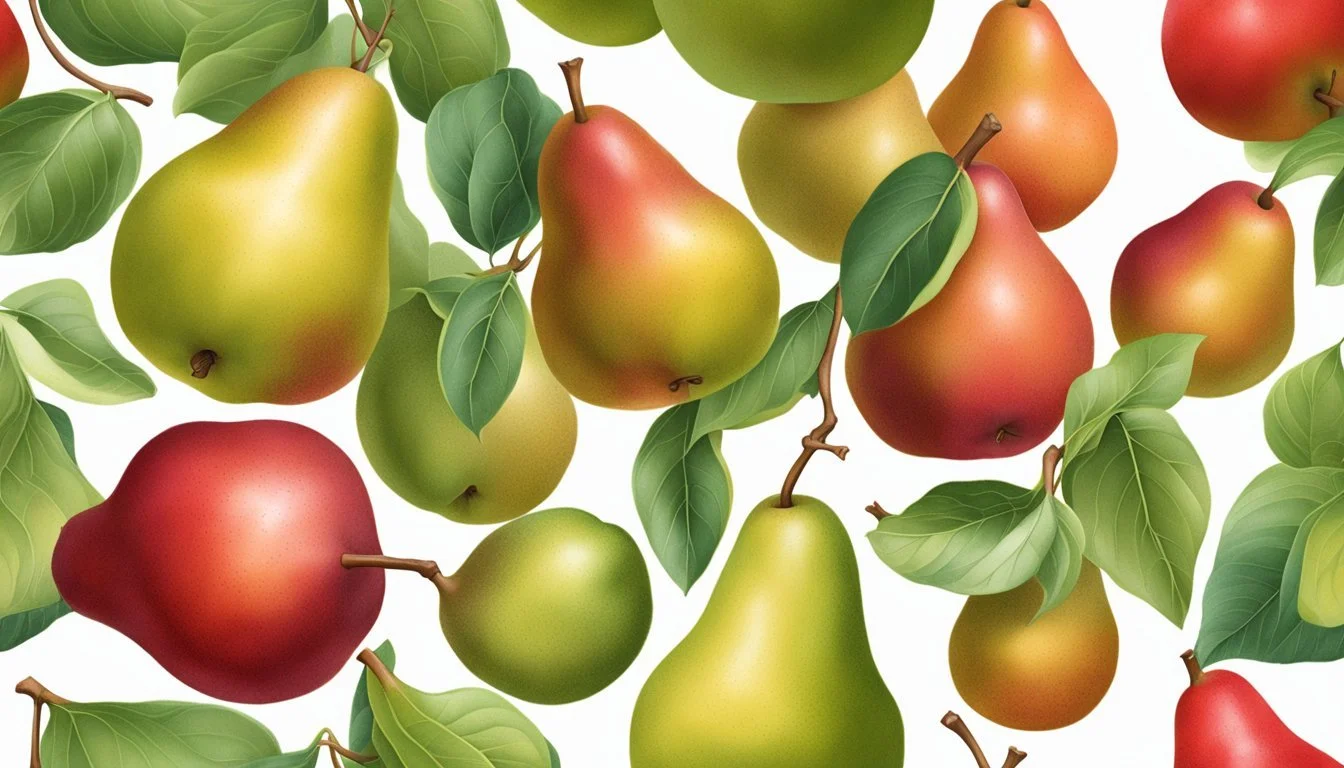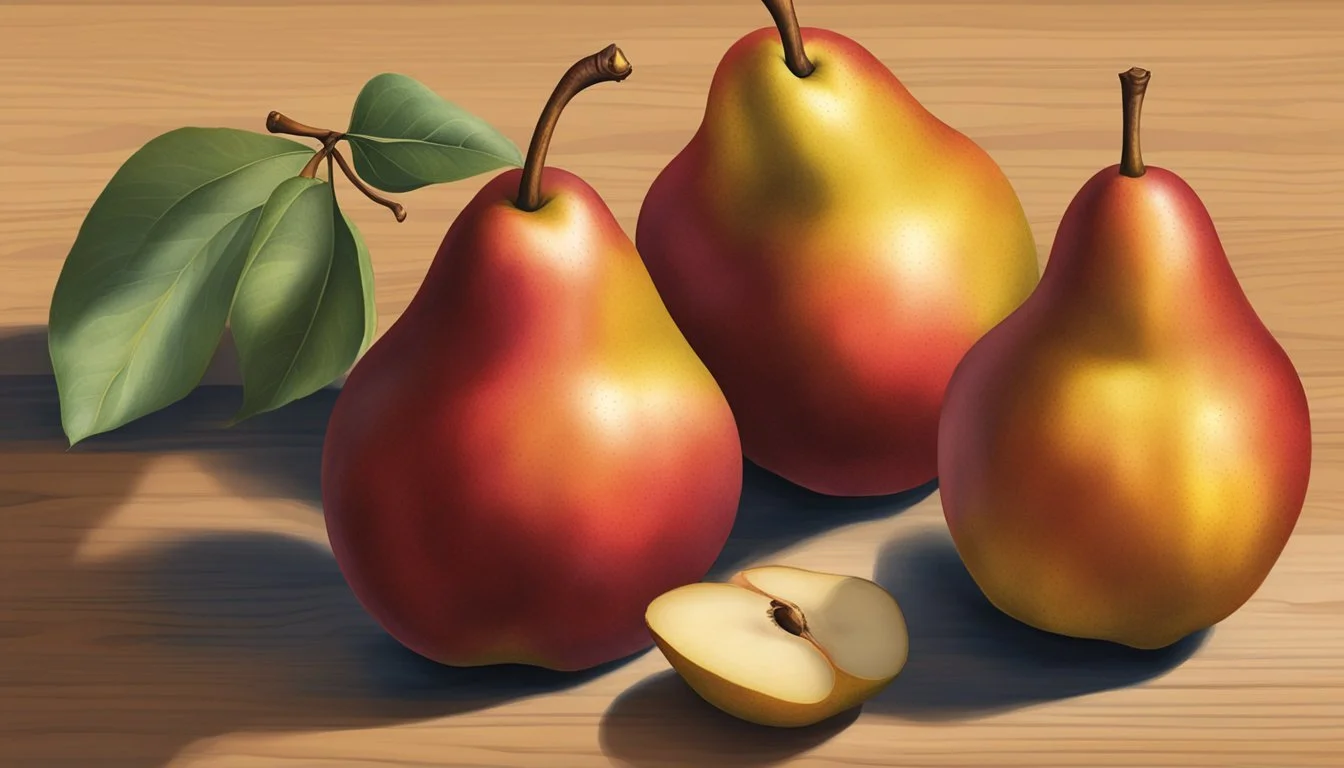How to Tell If Red Bartlett Pears Are Ripe
Your Ultimate Ripeness Checklist
Knowing when Red Bartlett pears are ripe for picking or consumption is essential for enjoying their optimal flavor and texture. These pears, like their green counterparts, undergo a transformation as they mature. Recognizing when a Red Bartlett pear is at its peak involves monitoring both its color and feel. As these pears ripen, their color shifts from a bright green to a vibrant red. However, color alone isn't the only indicator of ripeness; the firmness of the pear, particularly around the neck, plays a pivotal role in assessing whether it is ready to eat.
Assessing the ripeness of Red Bartlett pears goes beyond just the initial selection; it also involves proper ripening techniques, storage, and handling to maximize the fruit's potential. The process of ripening continues after harvest, and understanding how to encourage it within your home allows for a consistent experience of perfectly tender and sweet pears. Equipped with the right knowledge, anyone can select, ripen, and enjoy Red Bartlett pears at their best, as well as utilize them in various culinary applications.
Key Takeaways
Check the skin and neck firmness to assess a pear's ripeness.
Use at-home techniques to ripen pears post-harvest.
Store and handle Red Bartlett pears properly to maintain their quality.
Identifying Ripeness in Red Bartlett Pears
Determining ripe Red Bartlett pears involves observing color changes, feeling their texture, and noting aroma and flavor development. Recognizing these signs ensures you select pears at their peak sweetness and juiciness.
Visual Clues of Ripeness
Color Change: Initially, Red Bartlett pears exhibit a green hue which transitions to a vibrant red as they ripen. A deep, rich red color all around indicates a ripe pear.
Skin: Firstly, ripe Red Bartlett pears should show an even red color with no significant patches of green. On occasion, they may have a yellow or red blush enhancing the redness.
Tactile Indicators of Pear Ripeness
Texture: The pear's skin, when ripe, should yield slightly to pressure without feeling mushy. A ripe pear is often tender at the neck when gentle pressure is applied.
Firmness: Unlike other fruits whose entire body may soften, the neck of the pear is the best indicator of ripeness. If the neck feels firm, the pear needs more time to ripen.
Aroma and Flavor Profiles
Sweet Aroma: A noticeable, sweet fragrance emerges from ripe Red Bartlett pears, hinting at the readiness to eat.
Flavor: When ripe, it offers sweet and juicy flavors, a clear characteristic that distinguishes a ripe pear from an unripe one. Taste is a reliable tool for assessing ripeness in situations where visual and tactile assessments are challenging.
The Stages of Pear Maturation
Identifying the right time to pick a pear ensures that the fruit reaches its full flavor potential. This is especially important as pears mature off the tree and complete their ripening process during distribution and storage.
From Tree to Store
Pears are unique in that they are picked when they are mature, but not yet ripe. Mature pears have completed their growth phase on the tree, but their ripening, marked by the sweetening and softening of the fruit, occurs after harvest. The maturation of a pear can be checked by slight pressure near the stem; a mature Bartlett pear, for example, will give slightly under pressure.
Once harvested, they are cooled to slow ripening, ensuring that they do not become overripe before reaching the grocery store. This controlled environment will continue at supermarkets as pears are kept at optimal temperatures to maintain freshness until they are ready to be displayed for sale.
Understanding Pear Varieties
Different varieties of pears have varying maturation times. For instance:
Bartlett Pears: These change color as they mature, going from green to a lighter green with a possible red blush.
Red Anjou Pears: Maintain a deep red color, so look for a softer feel near the stem to indicate maturity.
Bosc Pears: These have a distinct elongated neck, and while the color doesn't change much, the neck will begin to soften when they are mature.
Comice Pears: Often used in gourmet fruit baskets, these become more aromatic and yield to gentle pressure once mature.
Asian Pears: Unlike other varieties, Asian pears are firm when ripe and are best picked when they have a crisp, sweet taste.
Each variety requires careful observation and handling to determine the perfect time for harvest that leads to the delicious, ripe fruit consumers enjoy. Understanding the variety's visual and tactile cues is essential for growers and distributors to ensure pears are picked at the right time and reach the consumers in peak condition.
Ripening Techniques at Home
When ripening Red Bartlett pears at home, one can rely on the pear's natural production of ethylene gas or use accelerated methods to speed up the process. By understanding these techniques, individuals can enjoy ripe pears at their peak flavor and texture.
Natural Ripening Process
Red Bartlett pears emit ethylene gas, a natural compound that encourages ripening. To facilitate the natural ripening process, one should place the pears at room temperature, away from direct sunlight. The pears are best kept on a counter where they can be monitored for softness, particularly around the stem or neck, which indicates ripeness. This process can take several days.
Accelerated Ripening Methods
For those who wish to expedite ripening, here are some effective methods:
Ethylene Co-Ripening: Red Bartlett pears can be placed in a paper bag with other ethylene-producing fruits such as bananas or apples. The concentration of ethylene gas inside the bag will increase, accelerating the ripening process.
Steps:
Place the Red Bartlett pear in a paper bag.
Add a banana, apple, or other ethylene-producing fruits such as avocados or apricots.
Loosely close the bag to allow for air circulation.
Check daily for softness at the neck of the pear to ensure it does not overripen.
Temperature Manipulation: Slightly warmer environments can also encourage quicker ripening. Keep the pears out of cold areas and consider placing them near other sources of warmth, but not directly in sunlight or next to heat appliances, as excessive heat can spoil the fruit.
By using these techniques, one can ripen Red Bartlett pears effectively at home, achieving the desired sweetness and texture.
Proper Storage and Preservation
Ensuring that Red Bartlett pears maintain their freshness and flavor requires proper storage techniques. Whether one aims for short-term consumption or long-term preservation, understanding the optimal conditions for storing these fruits is crucial.
Short-Term Keeping
For those planning to consume Red Bartlett pears within a few days, they should be kept at room temperature until they reach the desired ripeness. Once ripe, to prolong freshness, they should be moved to the refrigerator. It is important to store pears in a way that minimizes moisture accumulation. In a fridge, they can be kept in the crisper drawer which is specifically designed to maintain a consistent humidity level favorable for fruits. However, one should avoid storing these pears in plastic bags in the refrigerator as plastic can trap moisture and promote spoilage.
Room Temperature: Until ripe
Refrigerator: Once ripe, in the crisper drawer
Long-Term Preservation
For preserving Red Bartlett pears for extended periods, freezing and canning are viable options. Before freezing, it's recommended to cut the pears into halves or slices, and optionally blanch them in a light syrup to prevent browning. For canning, the pears should be peeled and halved, then processed in a water bath with syrup. Ensuring that canning jars and lids are sterilized before use is crucial to prevent contamination and spoilage.
Freezing:
Peel and cut into desired sizes.
Optionally blanch in light syrup.
Store in airtight containers or heavy-duty freezer bags.
Canning:
Peel and half the pears.
Use sterilized jars and lids for storage.
Process in a water bath with syrup.
Both methods will help maintain the firm texture and distinctive flavor of the pears for months, allowing one to enjoy their sweetness well beyond the harvest season.
Preparing and Cooking with Red Bartlett Pears
Before incorporating Red Bartlett pears into any dish, one should understand the proper preparation methods and acknowledge their versatile nature in recipes ranging from raw consumption to baked goods.
Washing and Preparing for Eating
To consume a Red Bartlett pear in its raw form, it must first be thoroughly washed under cool, running water. Once cleaned, the pear can be enjoyed in its entirety, bearing in mind the core and seeds are typically not eaten. An underripe pear will have a crunchy texture and be less juicy, while a ripe pear will display a juicy, tender profile suitable for immediate consumption.
Washing Tips:
Water Temperature: Cool
Method: Under running water
Cooking and Baking Applications
Red Bartlett pears, known for their sweet and slightly tart flavor, are a favorite in cooking and baking. As they ripen, they become juicier and develop a softer texture, which is ideal for sauces, jams, and fillings. These pears can be poached in red wine and spices like cinnamon or ginger for a warm dessert, or baked into pastries where their flavor complements the buttery dough.
Baking Ideas:
Poached pears with cinnamon
Pear tart with honey glaze
Pairing with Other Foods
The sweet and floral notes of the Red Bartlett pear make them an excellent complement to various cheeses, particularly sharp ones that contrast with the pear's sweetness. They can also be sliced and added to salads for a juicy crunch or drizzled with honey for a simple yet elegant dessert. The addition of honey not only enhances the natural sweetness of ripe pears but also provides a smooth texture contrast.
Food Pairings:
With cheese: Sharp cheddar, gorgonzola
In salads: Mixed greens, walnuts, feta cheese
Drizzled toppings: Honey, balsamic glaze
Health Benefits and Nutritional Value
Red Bartlett pears offer a notable nutritional profile rich in vitamins, minerals, and dietary fibers, contributing to their various health benefits.
Vitamins and Minerals Content
Red Bartlett pears are an excellent source of vitamin C, which plays a role in immune function and skin health. They also contain folate, which is necessary for cell division and producing DNA. This variety of pear offers a considerable amount of potassium, crucial for heart health and muscle function.
Vitamin C: important for the immune system and skin health.
Folate: vital for genetic material production.
Potassium: supports heart and muscle functions.
Nutrient: Calories
Amount per medium pear (approx.): 101 kcal
Nutrient: Carbohydrates
Amount per medium pear (approx.): 26.9 g
Nutrient: Dietary Fiber
Amount per medium pear (approx.): 5.52 g
Nutrient: Sugars
Amount per medium pear (approx.): 17.2 g
Nutrient: Protein
Amount per medium pear (approx.): 0.676 g
Nutrient: Vitamin C
Amount per medium pear (approx.): Varies, but generally high
Nutrient: Folate
Amount per medium pear (approx.): Varies, but contributes to RDA
Nutrient: Potassium
Amount per medium pear (approx.): Varies, but contributes to RDA
Dietary Impact of Pears
The dietary fiber in Red Bartlett pears is predominantly soluble fiber, which assists in maintaining healthy blood sugar levels and reducing cholesterol. Additionally, the antioxidants present in these pears can help protect the body from oxidative stress and may reduce the risk of certain diseases. They are relatively low in calories while offering a feeling of fullness, which can aid in weight management.
Soluble fiber: Helps control blood sugar levels and reduce cholesterol.
Antioxidants: Protect against oxidative stress and may lower disease risk.
Calories: A medium pear contains about 101 calories, allowing for satiety without high caloric intake.
Creative Uses in Recipes and Drinks
Red Bartlett pears bring a burst of sweetness and a vibrant color to a variety of recipes and drinks. Their versatility in the kitchen allows for exceptional culinary creations, from the simplest of desserts to rich and refined sauces.
Desserts and Sweet Treats
Poached Pears: Gently poach the Red Bartlett pears in a mixture of white wine, cinnamon, and a touch of sugar for a classic yet elegant dessert.
Baking: Slice the pears and incorporate them into pies, tarts, or a pear crisp, pairing them with spices such as nutmeg and cinnamon for added warmth.
Smoothies: Blend ripe Red Bartlett pears with Greek yogurt and honey for a creamy and nutritious smoothie.
Savory Applications and Sauces
Roasted Pears: One can roast Red Bartlett pears with root vegetables and drizzle them with a balsamic reduction to accompany a savory autumn dish.
Sauces: Create pear chutney or a savory pear sauce to serve alongside pork or chicken, offering a sweet balance to the meats.
Salads: Incorporate thinly sliced Red Bartlett pears into salads for a fresh, sweet contrast to bitter greens like arugula or endive.
Recognizing and Handling Spoilage
When determining if a Red Bartlett pear is past its prime, it is crucial to acknowledge specific spoilage indicators and take preventive actions to maintain freshness.
Signs of Overripe and Spoiled Pears
An overripe or spoiled pear often exhibits certain unmistakable characteristics. Consumers should look for:
Texture: A pear that feels excessively soft, especially if it yields to gentle pressure around the stem, may be overripe. When the flesh feels mushy, it's a clear sign of spoilage.
Appearance: Dark, sunken brown spots or bruises on the skin of the pear indicate over-ripening or rot.
Smell: A spoiled pear may exude a fermented or sour odor, which is indicative of decay.
If a pear displays such signs, it is advisable not to consume it as it may not offer the optimal taste and texture experience expected of fresh fruit.
Preventive Measures for Freshness
To extend the life of Red Bartlett pears and prevent spoilage:
Storage: Keep pears in a cool, dry place. If they are ripe and consumers wish to delay consumption, they should refrigerate the fruit.
Handling: Handle pears gently to avoid bruising, which accelerates spoilage.
Examination: Regularly inspect pears for signs of spoilage, and separate any that begin to turn overripe.
By implementing these strategies, shoppers can help ensure that their Red Bartlett pears remain firm and fresh for as long as possible.







